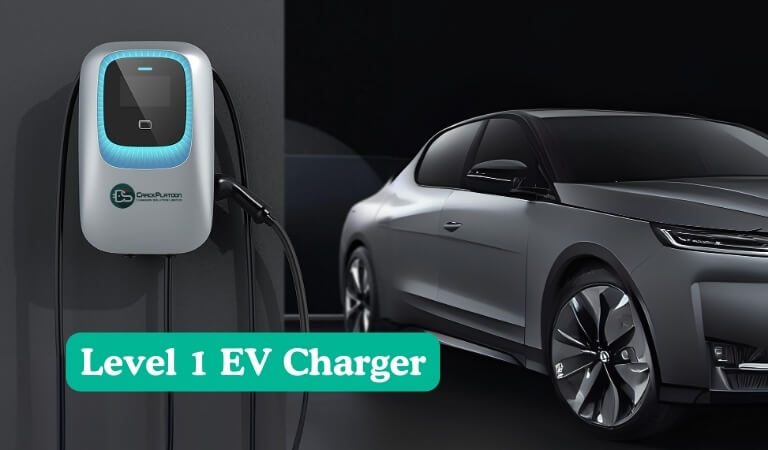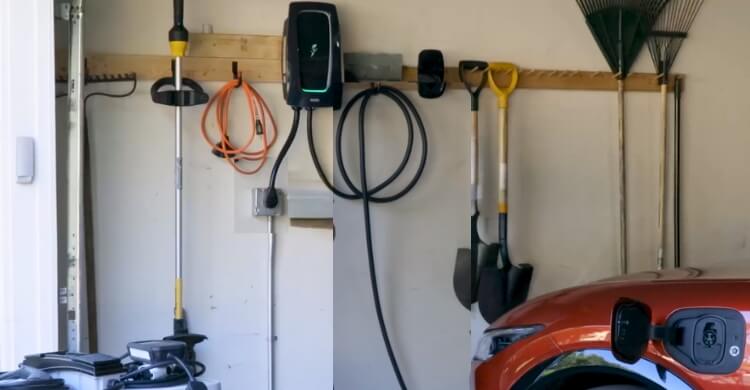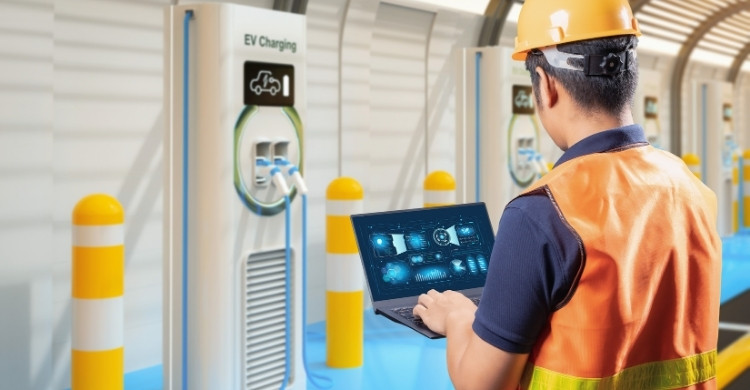As electric vehicles (EVs) continue to grow in popularity, understanding how to keep them charged has become more important than ever. With various charging options available, choosing the right one can impact both convenience and cost. Among the different types of chargers, one of the most common and accessible is the Level 1 charger. Now you might have a question: What is a Level 1 EV charger?
A Level 1 EV charger is a basic charging unit that connects your electric vehicle to a standard 120-volt AC wall outlet. It uses a dedicated circuit and is compatible with most EVs. This makes it a convenient option for slow, overnight home charging without needing special installation.
Read on to find out how it works, what it can do for you, and whether or not it is the best solution for your electric vehicle needs.
What Is a Level 1 EV Charger?
A Level 1 EV charger is the most basic and convenient way to charge your electric vehicle at home. It plugs into any regular 120-volt AC wall outlet, making it easy to use without extra equipment. Here are the features that make it so popular:

Simple Installation Process
Level 1 chargers don’t require professional installation. You simply plug it into a regular home outlet. No need for upgrades to your home’s electrical system. This easy setup makes it accessible to everyone, even without technical knowledge.
Slower Charging Speed
The charging speed is slower compared to other levels. It typically adds about 3-5 miles of range per hour. This may not suit drivers who need a fast charge. However, it’s enough for overnight charging and daily use.
Compatible With Most Electric Vehicles
Almost all electric vehicles can be charged with a Level 1 charger. This compatibility makes it a universal option for EV owners. Whether you’re in Japan, India, or using an EV charging service provider in Bangladesh, Level 1 chargers are widely supported. It provides flexibility for a wide range of vehicles.
Convenient Home Charging Option
For home use, level 1 chargers offer great convenience. You can charge your vehicle while you sleep, saving time. There’s no need to visit public charging stations. This level is perfect for daily commutes and light EV use.
Affordable and Cost-Effective
Level 1 chargers are the most affordable option for EV owners. Since no special installation is required, there are fewer upfront costs. It’s a budget-friendly solution for those who need basic charging. This makes it a popular choice for first-time EV owners.
Where is Level 1 EV Charging Most Useful?
The simplest way to charge an electric vehicle at home is to use Level 1 EV charging. It’s widely available and doesn’t require complicated installation. But where is it most useful? Let’s explore different scenarios where Level 1 charging can be a great choice.

Perfect for Home Charging
Charging at home overnight suits people with regular daily driving needs. No special installation is required, just a normal wall outlet. It charges slowly, which works well while you sleep. The daily EV charging impact is minimal when using a Level 1 charger at home. Many EV owners rely on this for daily charging needs.
Great for Apartment Living
Some apartments offer shared outlets in parking areas for EV owners. Level 1 charging works well in these low-power situations. Residents without high daily mileage benefit from this setup. It’s affordable and requires no major changes to the building. A convenient option for tenants and landlords alike.
Useful in Rural and Suburban Areas
In rural and suburban homes, access to regular outlets is common. Long drives aren’t always daily, so slower charging works. Many households already have outdoor sockets available. This saves money on setting up higher-level chargers. It supports EV use in less developed charging areas.
Ideal for Workplace Charging
Employees can plug in their vehicles during work hours using existing outlets. Eight hours at work gives a good charging window. Companies don’t need major upgrades for Level 1 charging. This encourages more staff to drive electric vehicles daily. Simple setups make workplace charging more accessible.
Helpful for Backup Charging
Even when you have faster chargers, Level 1 works as a backup. It’s useful during emergencies or power issues. You can always rely on a basic wall outlet. Keeping a Level 1 charger in the car is smart. It adds peace of mind for unexpected situations.
Fits Well in Public Parking Spaces
Some public lots offer Level 1 outlets for long-term parking. Travelers who park for hours can benefit from slow charging. This option supports EV users at libraries, offices, or community centers. It’s low-cost and easy to install in many places. More public spots are adding this option.
How to Know if a Level 1 Charger Suits Your Driving Habits?
Not all drivers need fast charging every day. Choosing the right charger depends on how far and often you drive. Let’s see if a Level 1 charger matches your driving habits.
Check Your Daily Driving Distance
Short commutes are perfect for Level 1 charging at home. It adds about 3 to 5 miles per hour. Those driving under 40 miles a day will manage well. Daily city driving usually suits this charger’s pace. Long-distance drivers may need something faster.
Think About Your Parking Setup
Charging is easiest when you park close to a regular outlet. Homes with garages offer the most convenience. Renters or apartment dwellers may face challenges. Shared parking doesn’t always have nearby plugs. Easy access makes daily charging much simpler.
Look at Your Charging Time
Level 1 chargers work best when cars sit parked for many hours. Overnight is the most practical charging window. Those with flexible routines benefit the most. Constantly moving drivers may want quicker options. Long stays at home make this charger shine.
Consider Travel Habits
Frequent weekend trips stretch a Level 1 charger’s limits. Topping off quickly before long drives isn’t its strength. Planning ahead becomes necessary for distant travel. Occasional trips are manageable with a backup plan. Every day use stays more reliable and relaxed.
Understand Your EV’s Battery
Battery size affects how fast a car charges. Smaller batteries fill up quicker with Level 1. Larger ones take much longer to charge fully. Knowing your battery capacity guides smart charger choices. The right match saves time and energy.
When Is It Time to Upgrade Your EV Charging Setup?
As electric vehicles become more popular, charging needs evolve. You might wonder when it’s time to upgrade your setup. Here’s a guide to help you decide when to make that change.

Slower Charging Times
There is nothing more frustrating than waiting hours for a few extra miles. A Level 1 charger works slowly, often overnight. Drivers with tight schedules need something faster. Charging speed becomes clearer when comparing Level 1 and Level 2 chargers, as the difference in time is significant. In the long run, you’ll save a great deal of time.
Frequent Power Interruptions
Regular charging issues could point to a system that’s too weak. Power drops or incomplete charges become common with overuse. A stronger setup supports consistent and reliable charging. Better stability means fewer interruptions and more confidence. Upgrading helps protect your car’s battery performance long-term.
Long-Distance Driving Needs
Daily short trips are easy to manage on slower chargers. But longer routes demand faster energy recovery. Quick top-ups between errands or travel days make a difference. A Level 2 charger keeps your battery fuller more often. Travel becomes smoother with quicker charge times.
Multiple EVs in One Home
Charging one car overnight might work fine alone. Adding another EV makes things more crowded. When you’re waiting for a charger, it becomes very inconvenient. Multiple vehicles can be handled without long delays by upgraded systems. Families with multiple EVs benefit from faster charging options.
Changes in Living Situation
A new home with a garage or better outlet access opens new possibilities. Having more space makes installation easier. Level 2 chargers fit well into homes designed for EVs. Better access leads to better charging habits. It’s a good moment to explore upgrade options.
Wanting More Speed and Comfort
Slower charging often feels manageable—until it doesn’t. A faster setup brings peace of mind before busy days. Convenience becomes a top priority for regular EV users. Fast charging offers that extra comfort when life moves quickly. The upgrade brings both speed and simplicity.
Tips to Extend Battery Life with Level 1 Charging Options
Charging your electric vehicle with a Level 1 charger may be slower, but it can actually help extend your battery’s lifespan. Using smart habits and simple care tips can make a big difference. Here are some useful ways to keep your battery healthy while using Level 1 charging.
- Avoid Charging to 100% Every Time: Keeping the battery between 20% and 80% helps reduce long-term stress. Full charges regularly can shorten overall battery life.
- Charge Overnight for Consistent Power Flow: Nighttime charging provides a steady power supply with less demand on the grid. This helps maintain balanced and safe charging sessions.
- Unplug After Reaching Desired Charge Level: Leaving your EV plugged in too long can create unnecessary heat. Controlled charging reduces wear and improves long-term battery performance.
- Park in a Cool, Shaded Area While Charging: High temperatures during charging can strain the battery. Shade or indoor charging helps control heat buildup and protect battery cells.
- Avoid Frequent Quick Top-Off Charges: Let the battery deplete moderately before recharging for best results. Frequent tiny charges may interrupt battery balancing cycles.
- Use the Manufacturer’s Recommended Charger: Following brand guidelines ensures your battery gets the right power flow. Compatible equipment also improves charging safety and efficiency.
- Update EV Software Regularly: Software updates often include battery management improvements. Staying updated helps your EV use energy more efficiently during every charge.
- Drive Smoothly Between Charges: Gentle driving lowers battery stress between charging cycles. Efficient driving habits support longer battery health alongside regular Level 1 use.
FAQs About What Is a Level 1 EV Charger?
New electric vehicle owners often choose Level 1 EV chargers because they are easy to use and affordable. Here are some frequently asked questions to help you better understand their features, limitations, and practical uses.
Can Level 1 Chargers Be Used in Extreme Weather Conditions?
Yes, Level 1 chargers can operate in extreme weather, but it’s essential to follow manufacturer guidelines. In freezing temperatures, charging speed may decrease. During heatwaves, avoid charging in direct sunlight to prevent overheating. Using weather-protected outlets can help ensure consistent and safe performance.
Is It Safe to Use Extension Cords with Level 1 Chargers?
Using extension cords with Level 1 chargers is not recommended unless approved by your EV manufacturer. Regular cords may not handle the continuous power draw safely. This could lead to overheating or fire hazards. Always use heavy-duty cords rated for outdoor use if absolutely necessary.
How Long Does It Take to Fully Charge an EV with Level 1?
Charging time depends on your EV’s battery size. A full charge on a 60 kWh battery may take over 24 hours. While this is slow, it suits those who drive shorter distances daily. It’s best used for overnight or long-duration charging at home.
Can You Install a Level 1 Charger Outdoors?
Yes, Level 1 chargers can be used outdoors if they are rated for exterior use. Ensure the plug and outlet are weatherproof. Outdoor-rated cords and covers provide added safety. Always check your charger’s label for outdoor compatibility before installation.
Does Level 1 Charging Affect Electricity Bills Significantly?
Level 1 charging uses a small amount of electricity over a longer time. Most users won’t see a huge spike in monthly bills. Charging overnight during off-peak hours can help reduce costs further. The impact is minimal compared to fuel costs for gas vehicles.
Are All EVs Compatible with Level 1 Chargers?
Almost all electric vehicles support Level 1 charging. Most EVs come with a Level 1 cable as standard. Some plug-in hybrids may charge faster due to smaller battery sizes. Always check the charging port type to ensure compatibility.
Is a Dedicated Circuit Necessary for Level 1 Charging?
Using a dedicated circuit is highly recommended. It reduces the risk of overloading your home’s electrical system. Shared circuits could cause tripped breakers or reduced efficiency. A dedicated line ensures safer, more reliable charging performance.
Can You Use Smart Features with Level 1 Chargers?
Some Level 1 chargers come with smart charging capabilities. These include app-based controls, charge scheduling, and energy monitoring. While basic models don’t offer this, newer ones are catching up. Smart features help you track usage and manage charging times better.
Final Thoughts
Level 1 EV chargers are a practical and accessible solution for everyday electric vehicle charging needs. They offer easy home installation, low upfront cost, and compatibility with most EVs. While slower than other options, they’re ideal for short commutes, overnight charging, and areas with limited infrastructure.
Being familiar with what is a Level 1 EV charger helps drivers make informed decisions based on their habits and lifestyle. It’s a dependable backup in emergencies and works well for those with steady routines. Although it may not suit long-distance drivers or multi-EV households forever, it’s a smart start for new owners. With proper care and usage, it can even improve battery life. As EV use grows, this charging option remains a reliable and efficient choice for many.
